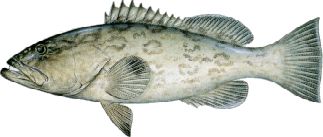
Mycteroperca microlepis*
Description: brownish gray in color with dark worm-like markings on sides; strong serrated spur at bottom margin of preopercle, less noticeable in large specimens; fins dark, with anal and caudal having white margin. Often confused with black grouper; tail of gag is slightly concave, black is square; gag has white margin on anal and caudal fins, black does not; under 10 pounds, gag’s spur on preopercle is distinctive, where black is gently rounded.*
Fishing Areas:
Mostly offshore rocks, ledges and cracks, but in the spring and fall they can be found in 8-12 feet of water.
Baits:
Live baits such as whitebait, pin fish works well. Cut bait or whole dead baits also work very well. There is a verity of large and ex-large deep diving lures used for trolling. Typically blind trolling is used to find the fish and works well in the spring and fall. Also trolling on or near know locations often produce fish.
Tackle:
Rod: A shorter heavy class rod.
Reel: A conventional reel with a heavy drag system (Spin gear used for inshore only)
Line: 40# and up mono or 50#+ braid.
Leader: A 60-100# mono or fluorocarbon leader (when the water is clear and the bite is slow).
Hooks: Circle hooks are required for all reef fishing, 5/0 – 10/0 depending on bait size.
Technique:
Overall grouper is one of the most sought out fish and one of the easiest to catch, however finding them is the hard part. Grouper fishing has become a very expensive venture. Since the travel distance is usually 40+ miles round trip, gas prices have made grouper fishing less appealing for the average fisherman.
But in the spring and fall the gag grouper will move in as close as a few miles offshore. This is when knowing the location of inshore rocks really pays off. The locations of these prized rock piles are highly guarded and most will not share this information. But that is not to say the average fisherman can not start find and collecting their own “Top Secret” list of inshore rocks.
The best time to start looking is the winter, when the water is cold and very clear and the tides are very low during the day. You will not find any grouper, but you can find where they where. If you are brave and cold water tolerant, you can cruise the 10 – 15 ft mark and when you see a large sandy area with a black center or edge, jump over to investigate. Or you can just mark the numbers and return when the water warms up. July and Aug are good times to hunt for rocks or check the numbers from the past winter, the water is not very clear, but it is much warmer. You may find a few stray little grouper hanging around the rocks. Typically you do not want to hunt for rocks when the fishing is good, you either go fishing or hunting, not both. If you jump over on a rock pile in shallow water the grouper will leave and return only after you have left.
When hunting you want to find rocks with a hole or holes under the rock. The grouper will use their tail to fan the rock making a hole under the rock, so they will have a place to hide and sleep. I have seen holes that go 10 feet under the rock in 7 feet of water. Once you find the holes note how the rock is positioned and the location of each hole.
Now that you have a few locations, inshore grouper fishing is much different than offshore fishing and requires skill and knowledge. First thing to note, the fish are spooked easily in shallow water. One rule of thumb that all fish know; if it’s bigger than you, it will try to eat you. If you have a 2000# boat, the grouper are scared of the boat. If you anchor on top of the rock the fish can feel pressure of the boat and they will leave. It’s best to anchor up current, as far away from the rock, but still be able to cast or drift a bait to it. Before you return to fish that rock check your notes for locations of the holes and lay of the rock. Try to land your bait with in a foot or so of the hole, once the bait hits the water hold on tight and be prepared to reel.
Always check the fishing regulations as they have changed several times in the last few years.
Grouper Pictures:
……………………………………………………………………………………………………………………………………………..A nice bunch of dinners.
If you have a picture(s) of gag grouper we would love to post it here, please send a request through the contact form for instructions.
* Identification Information From: myFWC
No Comments